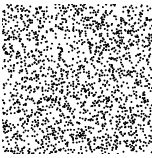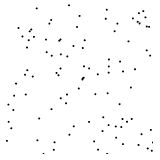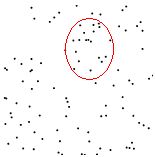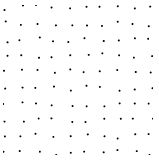Imagine these graphs show the location of those living with a fatal disease. There are clearly some places that don’t have the disease and other places that seem more prone to it. I even circled a clump to illustrate that something is clearly wrong with that area and we should do more research, or should we?
Let’s say we mark a dot every time we have a good or bad day. The whole year might look like this:

Looks like our stars weren’t aligned during a few months?
In both cases, we may be tempted to start trying to figure out why there is grouping, generating all kinds of reasons. We would probably even convince ourselves that our reasons are correct and start taking action based on them.
But we would be doing so in vain. The people living in the areas above did not pick some toxic swamp, neither did our year have misaligned stairs. This is just how things look when something happens randomly.
All of the above images show pure randomness — any and all clumps are entirely meaningless. This is not what we expect randomness to look like. We tend to think that randomness looks like this:
Sure there is a little variation, but things are evenly spread out. It feels right, it feels fair, and it may be, but it’s not random. This type of distribution requires a great deal of control to create.
Ever have a string of bad events and wonder why you’re having to suffer such a week, searching for a reason so we can make them stop?
Clumps don’t just happen graphically – clumps of occurrences happen all the time. We hunger for meaning so we notice the clumps and try to figure out why. With a plot, our eyes create gestalt groupings. In life, our brain does the same thing to coincidences. We want to assign meaning even when it’s most likely a random distribution. Part of it is that we don’t notice the long stretches when things don’t happen because we don’t remember the non-event — just like our eyes don’t immediately go to the open areas in the plots above.
Statistically, we can find ways to tease out the random noise from the valuable information, but it’s not trivial and requires a lot of data. Most of us are not statisticians, yet we have all assigned a reason to a set of coincidences. How often do we start making decisions based on stories we created because we couldn’t recognize what random actually looks like?
When we see things that seem coincidental to us and our minds tempt us to start assigning meaning, we should be cautious and probably not believe our own reasons. We aren’t wired to properly recognize randomness and our world is full of random events.
Related Posts: Where Superstitions Come From?
The plots were generated using some Javascript code. If you’d like to see more examples of what randomness actually looks like, you can just click here to try running it yourself (no programming experience required). Just change the values for size and number of points and click run. Let me know what you think?



Leave a Reply